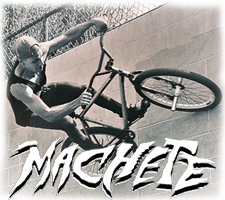
when i last left you on this series of essays, i dove into the origins of FGFS. it was quick, and basically spanned from the days of breaking carbon forks doing keo spins, into breaking everything doing 360 flyouts. now here comes the stuff that will make you either love what i'm saying or hate what i'm saying. get it after the jump.
Fixed 4 from Charge Bikes on Vimeo.
To Water The Infernal Gardens from AJ Austin on Vimeo.
(bet you forgot about that tom lamarche and aj austin. yeah you fucking did)
continuing from last time, FGFS companies were popping up left and right. companies like charge, leader, volume, and MKE were right at the forefront of the FGFS revolution. the frames were different but still pretty crude- most still used geometries that had roots in track bikes and ran really beefy forks which sometimes were derived from DJ bikes. this was a good and a bad thing: good because it was easier to transition into these new heavier duty rigs, bad because, there wasn't a ton of progression in technology.

(#BHSKDONTRIDE)
as for me, at this point i had followed the trends. remember how my SE lager looked like in the last post? back then it had a velocity deep v up in the front, an IMD wheel in the back (looking back, i'm kicking myself for going with a 43mm deep rim. what the fuck was i thinking?), short risers and a tree lite sprocket paired with demolition cranks. now it had velocity chukkers all around wrapped in velocity chukkers, uncut eighthinch bars and stem, and an MKE bruiser fork. things were changing.
Hold Fast Promo 1 from John Watson | The Radavist on Vimeo.
(OH SHIT IT'S JOHN PROLLY ON AN FGFS BIKE. loveyoujohndon'thurtmeplease)
probably the single greatest innovation (in my opinion) in the very few innovations of FGFS was the hold fast style foot retention. toe clips were a little dated and got in the way of tricks, plus they broke really fucking often. what hold fast did to the FGFS industry, however, is make the FGFS industry open season.
WRAHW Welcomes Oscar Khan from WRAHW on Vimeo.
Torey Thornton for The Grime from WRAHW on Vimeo.
(torey and oskar are my fucking heroes)
smaller, more niche companies came to the forefront: Grime bikes, unknown bike co, 14bikeco, BB17, a slew of strap companies, and resist came out to accommodate the needs of a more aggressive riding community. and with that, a handful of riders rose like cream in coffee; bike companies were sponsoring riders as if they were on par with BMX riders. in hindsight it was pretty fucking insane, especially since the entire premise of FGFS is basically doing the wrong types of tricks on the absolute wrong type of bike.
iMiNUSD Grand Opening | Quantum Trick Comp from iMiNUSD on Vimeo.
Minute Mondays: The Wheel Talk Compound from iMiNUSD on Vimeo.
(here are two edits from the same area but one year apart; 2010/2011. check the 700c to 26" ratio in the second video)
but shit still kept breaking, and a few riders believed the weak point was wheel size. with the origins of FGFS stemming from bikes with a 700c wheel size (which happened to be the same size as a 29er), some thought the natural progression would be to go to something with smaller, stronger spokes that offered more tire options. the 26" FGFS vs 29er FGFS debate came to the forefront as more and more riders made the switch to the smaller wheel. and it all happened so fast- around 2010 mosft FGFS stuff was based around 700c/29, come 2011 and everything had jumped the shark to the 26 inch stuff.
ED WONKA from Matt Reyes on Vimeo.
(oldie but goodie from one of the dudes who pioneered the 26" movement, wonka slays shit, and matt reyes makes rad edits)
that however kicked companies in the pants to make 26" specific frames. riders up until this point were riding frames and forks designed around a big wheel, but shoved the smaller 26" wheel under them. this made the bikes look pretty wonky in my opinion (that's why when destroy built my FGFS rig in 2011, i designed it around a 29er wheel). despite my personal feelings on the wheel size wars, i'd have to admit that 26" had made its way into being the wheel size of choice.
Michael Chacon NEW EDIT!!! from Michael Chacon on Vimeo.
Jakob Santos: Spike Parts from JBall on Vimeo.
(check the difference between mike chacon's edit and my boy jakob santos' edit. you can see a ton of BMX inspiration with jakob)
the 26" wheel marked a shift in FGFS where shit started to look a lot like big wheel BMX. we already had the drivetrain components from BMX, but now frames were being built with negative or no bottom bracket drop, pegs found their way onto bikes, companies started making essentially welded microdrive hubs- hell even the handlebars were getting taller and required a brace, just like BMX. ultimately, the tricks ended up looking like choppy ass BMX tricks (oh shit, here comes the hate).
_deadwood_ Man Up! from lockedcog on Vimeo.
(i dont regret putting this comp on. best shit i've been apart of hands down. damn i was kinda fat.)
now before you start spewing out your view and ripping my fucking head off, i'm not saying that we were better off doing BMX to start. FGFS just happened to go into a certain direction, and hell, even i got into that shit. and i still love that shit. but in my opinion (hold a few riders) the riding became much slower paced and gritty. it was hit or miss- a lot of edits were brilliant, a lot of edits were really choppy for the sake of trick progression. for a bike that requires a lot of momentum, the riding in this "new-school" era had some riding that lost a lot of momentum in rotations, in speed, and threading lines. and covering my ass here, i'm not pinning this on any individual or the fact that 26" became big.
BHSK's goes to red bull ride n style 2013 from BHSK_cogblog on Vimeo.
BHSK @ redbull ride n style 2014 from BHSK_cogblog on Vimeo.
(peak FGFS made redbull ride n style, then it kinda just vanished)
now back to what i was saying; FGFS specialty stuff was becoming higher in demand. problem was, it was becoming really fucking expensive. from a business standpoint, it makes sense why it was expensive; you see, the FGFS crowd was a small cross section of the "fixie" crowd, the "fixie" crowd is a small cross section of the track/singlespeed crowd, the track/singlespeed crowd is a small cross section of the road cycling crowd. not only that, there's little overlap from FGFS to BMX. so you can use BMX shit for FGFS, but not much vice versa. so if you think about it, these parts were really specialized to the point where parts were so expensive that it pretty much alienated the community that made it. FGFS peaked really quickly, then subsided even quicker.
so that's it. some grew out of FGFS, some ended up transitioning into BMX or skateboarding; stores closed, riders moved away from san jose (which unknowingly became the epicenter of FGFS for some reason), and companies stopped producing FGFS stuff... most kind of disappeared. shit, looking at this now, i may have made the ending of this seem all sad and abrupt and shit. but it doesn't really end there. there's been something coming back, i done seent it. look out for part III as a look into what i think about FGFS and it's state today.
jmik























No comments:
Post a Comment